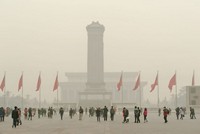Advertisement
Grab your lab coat. Let's get started
Welcome!
Welcome!
Create an account below to get 6 C&EN articles per month, receive newsletters and more - all free.
It seems this is your first time logging in online. Please enter the following information to continue.
As an ACS member you automatically get access to this site. All we need is few more details to create your reading experience.
Not you? Sign in with a different account.
Not you? Sign in with a different account.
ERROR 1
ERROR 1
ERROR 2
ERROR 2
ERROR 2
ERROR 2
ERROR 2
Password and Confirm password must match.
If you have an ACS member number, please enter it here so we can link this account to your membership. (optional)
ERROR 2
ACS values your privacy. By submitting your information, you are gaining access to C&EN and subscribing to our weekly newsletter. We use the information you provide to make your reading experience better, and we will never sell your data to third party members.
Pollution
Regulations improved air quality in China
Controls on emissions of fine particulates have prevented an estimated 370,000 deaths
by Katherine Bourzac
November 21, 2019
| A version of this story appeared in
Volume 97, Issue 46

In 2013, Beijing’s dangerous air quality repeatedly made the news, on some days exceeding an average of 1,000 µg/m3 of fine particulate matter. Chronic exposure to the air pollutant is associated with early death, cardiovascular disease, and respiratory ills such as asthma attacks, among other health problems.
That year, the Chinese government began regulating emissions of fine particulate matter with a diameter of 2.5 µm and smaller, also called PM2.5. Now researchers led by Kebin He and Jiming Hao at Tsinghua University report that this regulation was effective. From 2013 to 2017, people’s annual mean exposure to PM2.5 in the country dropped from 61.8 to 42 µg/m3. The World Health Organization recommends no more than 10 µg/m3 annually. Still, the researchers estimate the country’s regulations prevented 370,000 deaths during the study period (Proc. Natl. Acad. Sci. U.S.A. 2019, DOI: 10.1073/pnas.1907956116).
By combining chemical transport modeling with a detailed study of emissions inventories, the researchers attributed the drop in PM2.5 to specific regulations put in place by the government. They found that three measures accounted for 92% of the improvement: regulating industrial emitters, such as power plants; phasing out outdated equipment; and promoting clean residential fuels. Air pollution is still a problem in the country, however. The researchers note that 64% of Chinese cities failed to meet national PM2.5 standards in 2017. They hope their analysis of what kinds of regulations are effective will help guide future policy, in China and other countries.




Join the conversation
Contact the reporter
Submit a Letter to the Editor for publication
Engage with us on Twitter